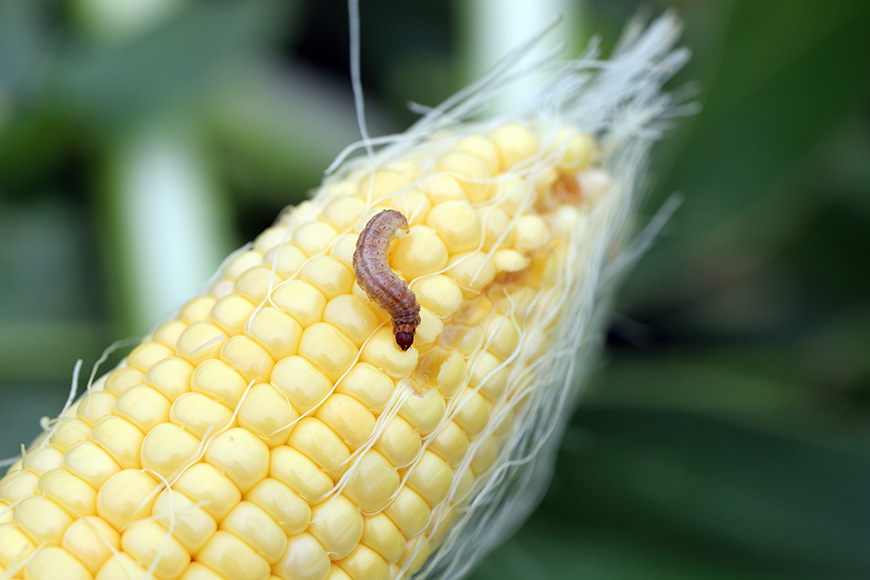Top Insects to Scout for in Corn and Soybeans
Isaac Anderson
Technical Seed Agronomist

A healthy, high-performing crop looks like success to us. To insects, however, it looks like a big, tasty meal. Managing pests in corn and soybeans is critical for protecting yield potential. They can creep up and wreak havoc fast, so it pays to stay ahead of the game.
Corn and soybeans face very different pest spectrums. As a grass, corn doesn’t attract much foliar feeding, while soybean leaves are a nutritious buffet for insects. Soybean tissue is more digestible for insects and their leaves are very nutrient dense. Each soybean trifoliate acts as its own solar panel, producing energy for only that specific part of the plant, meaning each leaf carries a lot of nutrient content. Since corn’s nutrient dispersion is much more segmented, it tends to get pests in more targeted areas, typically feeding more on the reproductive parts, such as the ears, silks and tassels.
As you’re scouting for insects this summer, keep an eye out for the most popular and destructive culprits.
Top 3 Corn Insects
- Corn Rootworm: This is by far the most common and expensive pest we deal with in corn, occurring both above and below ground. Larvae start hatching once 650-850 GDUs accumulate and begin feeding on root hairs and tissue, eventually burrowing into the roots. The root damage can limit nutrient and water uptake and impact standability, leading to lodging later in the season.About 10 days after larvae hatching, beetle emergence begins and typically continues for another 40 days. The beetles clip tassels, impacting reproduction and often resulting in poor ear fill. Every silk that gets clipped by a beetle leads to the loss of a kernel. These beetles can feed on dozens of silks per day. If you’re losing 10-12 kernels a day, you start to lose incremental yield loss very rapidly.
- Armyworm: The caterpillar is the damaging stage of this pest and can be very detrimental. Heavy armyworm pressure leaves corn stalks looking like cane poles. Armyworm larvae eat away at all the vegetative tissue they can find, leaving nothing but the stalk.
While armyworm can rapidly defoliate and decimate a field, they’re not as common as corn rootworm. They blow in with Southern winds and target corn acres that are surrounded by fields of broadleaves. It’s important to keep a careful eye out for this pest, however, because they can defoliate a field in a quick 3-5 days.
- European Corn Borers: This pest typically impacts corn in two major waves. The first generation at the beginning of the summer feeds on the leaf tissue and then halfway through its life, migrates to the stalk where it bores into it. This boring can make the plant susceptible to stalk rots and lodging later in the season.
The second generation feeds on reproductive parts of the plant, boring into ear shanks, feeding on the kernels and cob. If you do not have corn traited to handle above-ground insects like VT Double Pro®, SmartStax® or VT Triple Pro®, just one European corn borer maggot can wipe out an entire ear on its own.
Top 4 Soybean Insects
- Soybean Aphids: These tiny pests procreate very rapidly and infest any part of the plant above ground. They pierce plant tissue and suck out sap. This activity can also lead to mold growth and virus transmission. Soybean aphid feeding can result in yield losses up to 40%.1
- Twospotted Spider Mites: Like aphids, this pest is also very small and sucks nutrients out of the soybean plant, but it has a distinctive yellowish orange body and thrives in hot, dry conditions.
Infestations are typically recognized first in field borders, as the pest often moves in from other vegetation. Plants may present white or yellow stippling on the leaves, turning yellow to tan in severe situations.
- Grasshoppers: These defoliators eat away at soybean leaves at both the adult and nymph stage. There are many different species that feed on soybeans, leaving jagged holes and sometimes damaging seeds and pods.
- Thistle Caterpillars: Like grasshoppers, thistle caterpillars are major defoliators. Each larva will consume about 37.2 in2 of plant tissue.2
Insect Scouting Tips
Knowing how fast these insects can proliferate, I recommend scouting each field every 10-14 days, especially at key insect infestation times. This includes the transitional period from vegetative to reproductive stages. In corn, this is when tassels emerge, and ears start pushing silks. In soybeans, this is at flowering, which occurs around the summer equinox. Another key time is when plants are converting all their energy into grain. In corn, this is grain fill at R4-R5. In soybeans, it is pod fill at R3-R5.
As you’re scouting, look for key signs of pressure. In corn, you should be looking for silk health since that’s the number one thing corn rootworm beetles feed on. All silks should be pretty uniform in length. If you notice some that are shorter, it could be corn rootworm beetles clipping away at them.
Sticky traps applied around the tassel or upper vegetative region of the plant can also be helpful in corn rootworm beetle identification. Beetles move to the soil during reproduction so they’re not going to be as easy to spot on the plant, but sticky traps can catch them. If you find more than 3-4 beetles per day, you should probably consider a treatment.
When it comes to soybeans, we’re typically looking for foliar feeding and evaluating the degree of defoliation.
Most pests’ economic threshold isn’t until 30% defoliation. It can be alarming to see, but anything much less than that is typically cosmetic damage, meaning there aren’t significant yield implications.
Lastly, make sure you inspect the entire plant. Both spider mites and aphids can infect the top and bottom of the leaf as well as the stem.
Insect Management Tips
If you decide based on your scouting observations that an insecticide application is warranted, make sure you’re choosing the right active ingredient. There are several pyrethroid-resistant insects like aphids and weevils.
It’s also important not to get trapped in the “one and done” mindset. With the way insects reproduce, one application does not mean they won’t come back. Aphids, for example have a 7-10 day life cycle. So, if you kill all of them one day, 7-10 days later, you could have the same population you started with. It’s important to keep up on scouting and be prepared to apply again if needed.
Insect management and control can be complicated, but your local CROPLAN ag retail expert is always there to help you protect your seed investment. They have unique local knowledge and help farmers like you identify and manage pests every day. For more information and guidance, give them a call.
1 Soybean Aphid. Iowa State University Extension and Outreach. https://crops.extension.iastate.edu/encyclopedia/soybean-aphid
2 Thistle Caterpillar. Iowa State University Extension and Outreach. https://crops.extension.iastate.edu/encyclopedia/thistle-caterpillar
All photos are either the property of WinField United or used with permission.
© 2024 WinField United. Important: Before use always read and follow label instructions. Crop performance is dependent on several factors many of which are beyond the control of WinField United, including without limitation, soil type, pest pressures, agronomic practices and weather conditions. Growers are encouraged to consider data from multiple locations, over multiple years and to be mindful of how such agronomic conditions could impact results. CROPLAN and WinField are trademarks of WinField United.
IF YOU LOVE OUR INSIGHT, YOU’LL LOVE OUR ROI POTENTIAL
Every successful harvest starts with a seed. It just can't end there. Choose which high-performing seed products you’ll start with this season.



